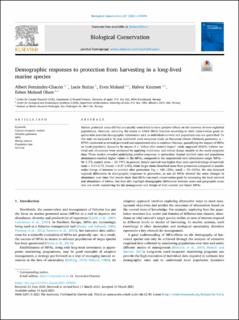| dc.description.abstract | Marine protected areas (MPAs) are usually considered to have positive effects on the recovery of over-exploited populations. However, resolving the extent to which MPAs function according to their conservation goals requires that essential demographic information such as individual survival and population size are quantified. To this end, we analyzed a 16-year replicated mark-recapture study on European lobster (Homarus gammarus, n = 8793) conducted at several protected and unprotected sites in southern Norway, quantifying the impact of MPAs on local population dynamics by means of a “before-after control-impact” study approach (BACI). Lobster survival and abundance were estimated by applying multi-state and robust design models to the mark-recapture data. These models revealed underlying positive responses to protection. Annual survival rates and population abundances reached higher values in the MPAs, compared to the unprotected sites (abundance range: MPAs = 96–1172, control areas = 92–747). In general, female survival was higher than male survival (range of survival: male = 0.13–0.75, female = 0.37–0.85), while larger males benefited more from protection compared to smaller males (range of increase in survival after protection: big = 100–125%, small = 55–101%). We also detected regional differences in demographic responses to protection, as not all MPAs showed the same changes in abundance over time. Our results show that MPAs can reach conservation goals by increasing the local survival and abundance of lobster, but they also highlight demographic differences between sexes and geographic areas that are worth considering for the management and design of both current and future MPAs. | en_US |
